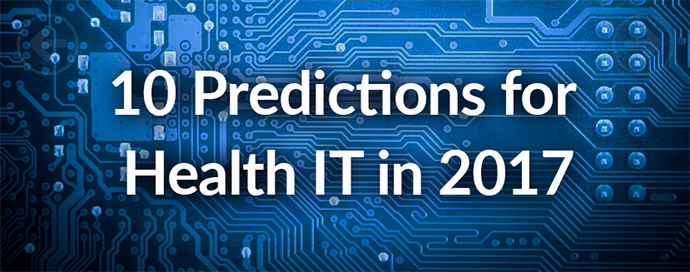10 Predictions for Health IT in 2017
 Technologies supporting digital transformation and the internet of things are one of many leading IT trends about to completely revamp healthcare delivery, predict global industry analysts at IDC, a leading IT advisory firm.
Technologies supporting digital transformation and the internet of things are one of many leading IT trends about to completely revamp healthcare delivery, predict global industry analysts at IDC, a leading IT advisory firm.
IDC’s research initiative identified the top 10 global health IT predictions most likely to impact healthcare enterprises, companies, and departments in 2017, and beyond. Industry analysts also assessed how long it may take these predictions to secure a tangible mainstream influence on the greater healthcare industry.
Security Concerns
According to Lynne Dunbrak, IDC Health Insight’s Research Vice President, focusing on the prevention of ransomware attacks is one of many top priorities for the year ahead.
“Threat factors are increasing in number and scope of attacks because healthcare organizations are perceived by cybercriminals to be soft-hearted,” Dunbrak explained during an on-demand webcast.
“Medical records have a greater black market value than credit card numbers or social security numbers,” she stated. “Depending upon what numbers and statistics you look at, it could be 50 times the value of medical records.”
Engaging Patients
IDC analysts also predicted that the healthcare IT industry will specifically utilize technologies that advance active – rather than passive – patient engagement.
“We’ve been pretty primitive in how we’ve tried to engage patients,” said Cynthia Burghard, IDC Health Insight’s Research Director, Accountable Care Organizations, during the webcast. “We’ve put up portals. Consumers don’t go there,” she noted.
“Really providing [consumers] with tools they can actively use to manage their health is important,” stated. “But you have to make it easy. You can’t create these form factors that people of my age can’t read. It needs to be very simple and easy to use,” Burghard advised.
IDC researchers also said data collected from wearable devices will advance patient engagement in coming years. Greater emphasis will soon be placed on the application of predictive analytics through artificial intelligence, they added.
“By 2020, adjustments to care plans will be made in real time and it will be as a result of data coming off wearable devices and being analyzed in a cognitive artificial intelligence environment,” said Burghard.
Here is IDC’s full list of top 10 global 2017 healthcare IT industry predictions:
- By 2018, There Will Be a Doubling of Ransomware Attacks on Healthcare Organizations
- By 2019, There Will Be a 50% Increase in the Use of Robots to Deliver Medications, Supplies, and Food Throughout the Hospital
- By 2019, 60% of Healthcare Applications Will Collect Real-Time Location Data and Clinical IoT Device Data and Embed Cognitive Capabilities to Discover Patterns, Thereby Freeing Up 30% of Clinicians' Time
- By 2020, 20% of Payers Will Offer Personalized Benefits with Options for a Consumer to Dynamically Reduce Premium and/or Alter Deductible/Copay by Disclosing Personal
- By the End of 2018, Payers Will Have Saved $1 Billion Globally Through Implementation of Robotic Process Automation (RPA) Tools, Skill Sets, and Process Reengineering
- In 2017, Patient Engagement Across the Life Science/Healthcare Ecosystem Will Jump from Passive to Active
- By 2020, 70% of the Developed Nations Will Homogenize Health Insurance with the Rest of the World, Moving to Replace Self/Employer-Based Options with Expanded Government Sponsorship
- Seeking a Passive Way to Measure Patients' Vital Signs and Other Biometrics, More than 40% of Healthcare Organizations Across the World Will Use IoT-Enabled Biosensors by 2019
- By 2020, Care Plan Adjustments Will Be Made in Real Time with Cognitive/AI Using Data from Wearable Devices, Resulting in 20% More Patients Being Engaged in Their Health
- By 2018, Drug Makers Will Double Their Investment in Analytics Focused on HCP Data to Reach Millennial and Gen X Doctors the Way They Prefer It — Electronically
See how 2016’s list compares here.